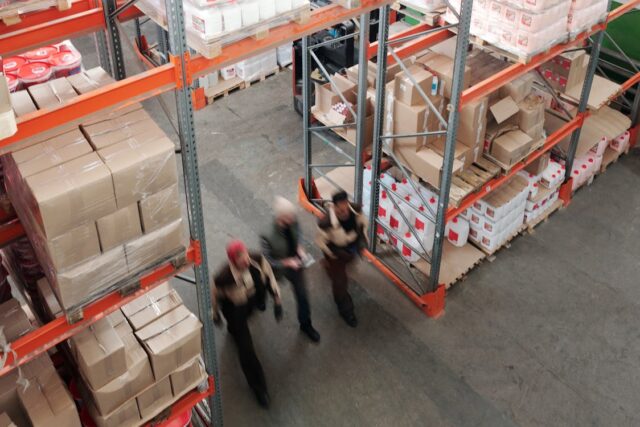Material handling is a critical aspect of warehouse management that can significantly impact productivity, efficiency, and safety. When not properly managed, material handling issues can lead to costly delays, equipment damage, and even injuries.
This guide provides warehouse managers with practical solutions to common material handling challenges, offering actionable insights to help you optimize your operations. For more in-depth strategies and tools to enhance your warehouse management, visit https://lenokers.com/.
Inefficient Workflow Design

One of the most common issues in material handling is an inefficient workflow design. A poorly planned layout can lead to unnecessary movement of goods, wasted time, and increased labor costs. For example, if frequently used items are stored far from the picking area, workers spend more time walking than necessary, reducing overall productivity.
- Solution: Optimize your warehouse layout by analyzing the flow of materials. Implement a layout that minimizes travel time and maximizes efficiency. Consider using automation tools like warehouse management systems (WMS) to help design and manage your workflow more effectively.
Overloading and Equipment Damage
Overloading equipment such as forklifts, conveyors, or shelving can lead to serious damage and safety hazards. When equipment is pushed beyond its limits, it not only risks breaking down but also endangers the workers using it.
- Solution: Train your staff on the correct usage of equipment and the importance of adhering to weight limits. Regularly inspect and maintain your equipment to ensure it is in good working condition. Implement load-balancing strategies to distribute the weight evenly and prevent overloading.
Inadequate Training
Improperly trained staff can cause a range of material handling issues, from inefficient processes to safety incidents. Workers who are unfamiliar with the proper handling techniques or the operation of machinery may inadvertently cause damage to goods, equipment, or even themselves.
- Solution: Invest in comprehensive training programs for all employees, focusing on both the technical and safety aspects of material handling. Regularly update training to incorporate new equipment, technologies, or procedures.
Poor Inventory Management
Inaccurate inventory management can lead to stock discrepancies, lost items, and delays in order fulfillment. When inventory is not correctly tracked, it can cause confusion, leading to misplaced goods and inefficient picking processes.
- Solution: Utilize inventory management software to keep accurate records of stock levels, locations, and movements. Implement regular cycle counts to ensure inventory accuracy and address any discrepancies promptly.
Safety Hazards

Safety is a major concern in material handling. Hazards such as unmarked walkways, cluttered workspaces, or improper lifting techniques can lead to accidents and injuries. These incidents not only harm employees but also disrupt operations and increase costs due to downtime and workers’ compensation claims.
- Solution: Implement strict safety protocols, including clear signage, well-maintained walkways, and proper lifting techniques. Regularly conduct safety audits to identify potential hazards and address them promptly. Encourage a culture of safety where employees feel empowered to report unsafe conditions.
Strategies for Effective Material Handling
Implementing Automation: Automation can significantly improve material handling efficiency by reducing the need for manual labor and minimizing the risk of human error. Automated guided vehicles (AGVs), conveyor systems, and robotic picking systems can all contribute to a more streamlined operation.
Benefits of Automation:
- Increased Speed: Automated systems can move goods faster than manual processes, reducing cycle times and improving throughput.
- Consistency: Automation ensures that tasks are performed the same way every time, leading to fewer errors and higher quality.
- Safety: Automated systems can operate in hazardous environments without risking worker safety.
Lean Manufacturing Principles
Lean manufacturing principles focus on reducing waste and improving efficiency. By applying these principles to material handling, warehouse managers can streamline operations and reduce unnecessary movements, leading to cost savings and improved productivity.
- Key Lean Practices: 5S (Sort, Set in order, Shine, Standardize, Sustain): Organize the workspace to ensure that everything is in its place and easily accessible.
- Value Stream Mapping: Analyze the flow of materials to identify and eliminate waste.
- Kaizen: Encourage continuous improvement by regularly reviewing and refining processes.
Ergonomic Solutions
Ergonomics plays a crucial role in material handling by reducing the physical strain on workers. Poor ergonomic practices can lead to musculoskeletal injuries, which not only harm employees but also reduce productivity due to absenteeism and increased healthcare costs.
- Ergonomic Solutions: Adjustable Workstations: Provide workstations that can be adjusted to suit the height and comfort of individual workers.
- Lifting Aids: Use lifting aids such as hoists, pallet jacks, or vacuum lifters to reduce the need for manual lifting.
- Proper Lifting Techniques: Train employees on proper lifting techniques to minimize the risk of injury.
Use of Technology in Material Handling

Technology can greatly enhance material handling processes by providing real-time data, improving accuracy, and facilitating better decision-making. Warehouse management systems (WMS), barcode scanning, and RFID technology are just a few examples of how technology can be leveraged in material handling.
Technological Tools:
- Warehouse Management Systems (WMS): A WMS can track inventory, manage orders, and optimize warehouse layout, leading to more efficient material handling.
Barcode Scanning: Barcode scanners ensure accurate tracking of goods as they move through the warehouse. - RFID Technology: RFID tags can be used to track items in real time, providing greater visibility into inventory levels and movements.
Managing Large and Heavy Items
Handling large and heavy items can be particularly challenging, as it requires specialized equipment and techniques. Improper handling of these items can lead to damage, injuries, and operational delays.
- Solution: Invest in equipment designed for heavy lifting, such as forklifts, cranes, or pallet jacks. Ensure that employees are trained in the safe handling of large items and that the equipment is regularly inspected and maintained.
Dealing with Hazardous Materials
Hazardous materials require special care in handling, storage, and transportation. Failure to properly manage these materials can result in serious safety incidents, environmental damage, and regulatory fines.
Solution: Implement strict protocols for handling hazardous materials, including proper labeling, storage, and disposal procedures. Train employees on the risks associated with hazardous materials and how to handle them safely. Ensure compliance with all relevant regulations and standards.
Handling High-Value Items
High-value items, such as electronics or luxury goods, require extra security and care during handling. Damage or loss of these items can lead to significant financial losses and damage to your company’s reputation.
- Solution: Implement additional security measures, such as surveillance cameras, access controls, and secure storage areas for high-value items. Use specialized packaging and handling techniques to protect these items from damage.
Managing Seasonal Peaks
Seasonal peaks, such as the holiday season, can put additional strain on your material handling processes. Increased order volumes, coupled with the need for faster processing times, can lead to bottlenecks and delays.
- Solution: Plan for seasonal peaks by forecasting demand and adjusting your staffing and resources accordingly. Consider implementing temporary automation solutions or hiring seasonal workers to help manage the increased workload.
Conclusion
Material handling is a complex and critical component of warehouse management. Regularly review your material handling processes, involve your employees in problem-solving, and stay adaptable to changing conditions. By doing so, you’ll be well-equipped to overcome material handling challenges and drive your warehouse toward greater success.










